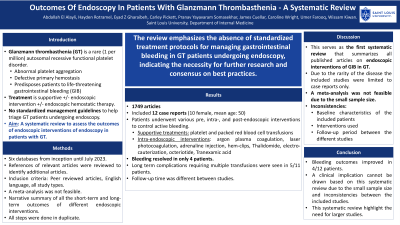Tuesday Poster Session
Category: General Endoscopy
P4115 - Outcomes of Endoscopy in Patients With Glanzmann Thrombasthenia: A Systematic Review
Tuesday, October 29, 2024
10:30 AM - 4:00 PM ET
Location: Exhibit Hall E

- AE
Abdallah El Alayli, MD
SSM Health Saint Louis University Hospital
St. Louis, MO
Presenting Author(s)
Abdallah El Alayli, MD1, Hayden Rotramel, MD2, Eyad Z. Gharaibeh, MD1, Carley Pickett, DO1, Pranav Yayavaram Somasekhar, MD1, James Cuellar, MD1, Caroline Wright, MD1, Umer Farooq, MD1, Wissam Kiwan, MD3
1SSM Health Saint Louis University Hospital, St. Louis, MO; 2SSM Health St. Louis University Hospital, St. Louis, MO; 3Saint Louis University, St. Louis, MO
Introduction: Glanzmann thrombasthenia (GT) is an inherited functional platelet disorder that can predispose patients to life-threatening gastrointestinal bleeding (GIB). In GT, GIB usually prompts diagnostic endoscopies that may show spontaneous mucosal bleeding without obvious culprits. There are currently no standardized management guidelines to help triage GT patients undergoing endoscopy. Our group conducted a systematic review to raise awareness about this orphan disease among gastroenterologists and to highlight the interventions and the potential complications of endoscopy in patients with GT.
Methods: An experienced librarian searched six databases. We included peer-reviewed articles that were published in English language. The reviewers abstracted details of the pre-post and intra-endoscopic interventions for GIB in patients with GT. All steps were done in duplicate.
Results: Of 1749 articles, we included twelve case reports from nine different countries (mean age 50; 10 female). In all studies the indication for endoscopy was anemia due to suspected GIB. Patients underwent various pre, intra-, and post-endoscopic interventions (table 1) to control active bleeding. Bleeding resolved in only four patients with the endoscopic interventions while eight continued to bleed despite interventions. Long term complications requiring multiple transfusions were seen in 5/11 patients.
Discussion: Our review underscores the complexities of treating GIB in patients with GT and highlights the need for further research into understanding the pathophysiological mechanisms specific to GT. Peri-endoscopic intervention strategies varied widely and carried inconsistent success at bleeding cessation. Clinicians and endoscopists may consider the medical and endoscopic treatment options summarized here when encountering GIB in patients with GT, until more data is available to standardize therapy.
Given how rare this disease is, it is very likely that performing large prospective or retrospective studies to determine the best standards of care in managing these patients endoscopically might not be feasible.
Note: The table for this abstract can be viewed in the ePoster Gallery section of the ACG 2024 ePoster Site or in The American Journal of Gastroenterology's abstract supplement issue, both of which will be available starting October 27, 2024.
Disclosures:
Abdallah El Alayli, MD1, Hayden Rotramel, MD2, Eyad Z. Gharaibeh, MD1, Carley Pickett, DO1, Pranav Yayavaram Somasekhar, MD1, James Cuellar, MD1, Caroline Wright, MD1, Umer Farooq, MD1, Wissam Kiwan, MD3. P4115 - Outcomes of Endoscopy in Patients With Glanzmann Thrombasthenia: A Systematic Review, ACG 2024 Annual Scientific Meeting Abstracts. Philadelphia, PA: American College of Gastroenterology.
1SSM Health Saint Louis University Hospital, St. Louis, MO; 2SSM Health St. Louis University Hospital, St. Louis, MO; 3Saint Louis University, St. Louis, MO
Introduction: Glanzmann thrombasthenia (GT) is an inherited functional platelet disorder that can predispose patients to life-threatening gastrointestinal bleeding (GIB). In GT, GIB usually prompts diagnostic endoscopies that may show spontaneous mucosal bleeding without obvious culprits. There are currently no standardized management guidelines to help triage GT patients undergoing endoscopy. Our group conducted a systematic review to raise awareness about this orphan disease among gastroenterologists and to highlight the interventions and the potential complications of endoscopy in patients with GT.
Methods: An experienced librarian searched six databases. We included peer-reviewed articles that were published in English language. The reviewers abstracted details of the pre-post and intra-endoscopic interventions for GIB in patients with GT. All steps were done in duplicate.
Results: Of 1749 articles, we included twelve case reports from nine different countries (mean age 50; 10 female). In all studies the indication for endoscopy was anemia due to suspected GIB. Patients underwent various pre, intra-, and post-endoscopic interventions (table 1) to control active bleeding. Bleeding resolved in only four patients with the endoscopic interventions while eight continued to bleed despite interventions. Long term complications requiring multiple transfusions were seen in 5/11 patients.
Discussion: Our review underscores the complexities of treating GIB in patients with GT and highlights the need for further research into understanding the pathophysiological mechanisms specific to GT. Peri-endoscopic intervention strategies varied widely and carried inconsistent success at bleeding cessation. Clinicians and endoscopists may consider the medical and endoscopic treatment options summarized here when encountering GIB in patients with GT, until more data is available to standardize therapy.
Given how rare this disease is, it is very likely that performing large prospective or retrospective studies to determine the best standards of care in managing these patients endoscopically might not be feasible.
Note: The table for this abstract can be viewed in the ePoster Gallery section of the ACG 2024 ePoster Site or in The American Journal of Gastroenterology's abstract supplement issue, both of which will be available starting October 27, 2024.
Disclosures:
Abdallah El Alayli indicated no relevant financial relationships.
Hayden Rotramel indicated no relevant financial relationships.
Eyad Gharaibeh indicated no relevant financial relationships.
Carley Pickett indicated no relevant financial relationships.
Pranav Yayavaram Somasekhar indicated no relevant financial relationships.
James Cuellar indicated no relevant financial relationships.
Caroline Wright indicated no relevant financial relationships.
Umer Farooq indicated no relevant financial relationships.
Wissam Kiwan indicated no relevant financial relationships.
Abdallah El Alayli, MD1, Hayden Rotramel, MD2, Eyad Z. Gharaibeh, MD1, Carley Pickett, DO1, Pranav Yayavaram Somasekhar, MD1, James Cuellar, MD1, Caroline Wright, MD1, Umer Farooq, MD1, Wissam Kiwan, MD3. P4115 - Outcomes of Endoscopy in Patients With Glanzmann Thrombasthenia: A Systematic Review, ACG 2024 Annual Scientific Meeting Abstracts. Philadelphia, PA: American College of Gastroenterology.

